It happened a few weeks ago when my mom was visiting. I had mentioned to her that all over Paris you can see plaques commemorating famous authors, philosophers, artists, historians, etc. Once you discover them, you start to see them everywhere, but after a while the novelty fades and you stop noticing them as if they are simply another doorway, cathedral, or flower-filled window box, just an ordinary piece of your everyday environment.
Still, I had told my mom that I’d show some to her, and that’s not something she’d forget, and so it wasn’t a surprise to me when a few days before she left she said, “Where are all of these plaques you kept talking about?” We were on Rue de la Seine, just a few steps from my apartment. “I don’t know,” I said, in a rush to get back to my apartment after walking ten miles in one day. “There’s one now.” I pointed to a random plaque hanging above a door.
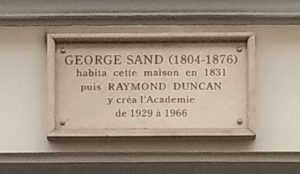
This time, rather than simply walking by, I did a double take. The name on the plaque was George Sand, one of the women on my short list of authors to read just hanging around a minute and a half from my apartment. I walk on her street almost every day on my way to the Seine, when I feel like side stepping busy Rue Saint-André des Arts. And I’ve never noticed her before. The whole thing got me thinking, what else have I missed these past three months? Perhaps my upcoming move to le Marais, though it’s a mere 25-minutes from the Left Bank to the Right, has made me nostalgic for an area that has quickly become my familiar. And so with only a few days left in the 6th, I thought I’d take a little staycation to discover what else is in my neighborhood.
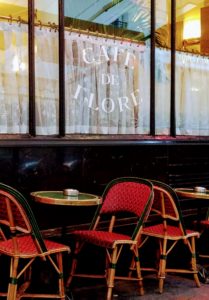
I’ve been living in Saint-Germain-des-Prés, the land of legendary cafés: Les Deux Magots, Café de Flore, Brasserie Lipp, and le Procope, though on this trip I’ve been seeking out lesser-known places (and if I’m in the mood for one of the big cafés, I’ll trekked over to Montparnasse to le Select). But today is a day for legends, so I head for Café de Flore for le petit déjeuner, a simple croissant and café crème. It is chilly out, with rain looming, the perfect day to be inside, to hang out at a café or get lost in a museum, though I decide to sit outside with the smokers, under an overhead heater, clinging to the ambling days of autumn.
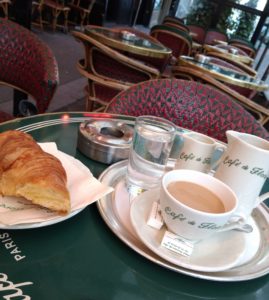
After breakfast, I step back out on the streets and walk just a few minutes to the Musée National Eugène Delacroix. As you know, I’ve been having bit of a love affair with Delaroix, after almost getting arrested while staring at one of his paintings at the Louvre (okay, maybe not arrested arrested). But it wasn’t until just a few weeks ago that I learned there’s an entire museum devoted to him in my neighborhood, literally (and I mean literally literally) just around the corner from my apartment à la Place de Furstenberg..
This quiet and somewhat unknown museum is at the site of the artist’s former residence, studio, and private garden. While there are a few visitors this early November morning, I often have the rooms to myself. The collection, primarily comprised of drawings, sketches, photographs of the artist, and souvenirs from his travels in Morocco, is small, charming, and intimate, especially after seeing some of his larger masterpieces at the Louvre. I especially enjoy entering his atelier and then strolling the tranquil garden behind the studio.
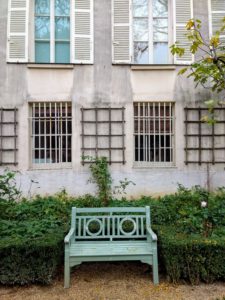
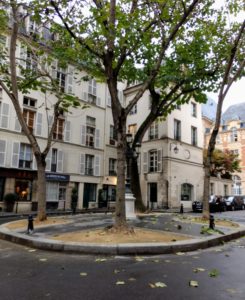
After my Delacroix feast I walk over to La Monnaie de Paris which faces the Seine. The Paris Mint is a government-owned institution that produces France’s Euro coins, but there is also a museum located there, Musée du Conti. The museum recently reopened, and there is currently an exhibition there that I want to see. But when I arrive, the man at the entrance tells me that they don’t open until onze heures, and it’s only just past ten. So I decide to take a detour at Shakespeare & Company, not really in my neighborhood, but still pretty close.
As I meander to Boulevard Saint-Michel, I’m aware that at mid-morning the normally lively quartier is still half asleep; most of the shops and restaurants that line the narrow streets aren’t even open yet. Today, even the almost-always bustling Fountaine Saint-Michel — typically crowded with camera-bearing tourists or clipboard-bearing activists — is relatively still. Truck drivers deliver heavy boxes of canned goods and today’s produce to restaurant doorways. At tiny cafés people linger over café creme and tartine de confiture, and on the sidewalks workers take their midmorning cigarette breaks, scrolling their cell phones or talking with friends (who am I kidding? midmorning cigarette breaks can come at any time of day in Paris, but especially ten minutes after I’ve asked for l’addition).
Walking through Paris at night may be the stuff of love stories in the movies, but as I approach Shakespeare and Company under a cloak of grey, my feet pinging last night’s puddles, I’m aware of the unexpected romance of uncrowded, cloudy mornings.

The original Shakespeare and Company, owned by American Sylvia Beach, opened in 1919 on Rue Dupuytren before moving to 12 rue de l’Odeon (also in my neighborhood) in 1922. Her shop, part bookstore and part lending library, was a gathering place for aspiring writers: Ernest Hemingway, F. Scott Fitzgerald, Ezra Pound, Gertrude Stein, Ford Madox Ford, Djuna Barnes (and on and on). Interestingly, at the original shop location there is a memorial plaque, but it’s to let the world know that Sylvia Beach published James Joyce’s Ulysses there (which she did, in 1922, when no one else would), not that she once ran a bookstore there (which, again, she did). The original store closed in 1941 during the German occupation of France in World War II.
Its current location opened in 1951 in the 5th arrondissement. I imagine if you’re a literary nerd who’s been to Paris you’ve taken a photo of it from atop Notre Dame before rushing over to peruse its shelves. The store was modeled after Sylvia Beach’s store but was originally called Le Mistral. However, storeowner George Whitman changed its name to Shakespeare and Company in tribute to Sylvia Beach after her death in 1964 (and, fun fact, on the 400th anniversary of William Shakespeare’s birth). Today it’s run by Sylvia Whitman, George’s daughter (named after Sylvia Beach herself) and continues to be a literary hub in Paris, selling new and used books, providing a free reading library, hosting a range of events, and offering a place to stay for aspiring artists and writers in exchange for helping out in the store.
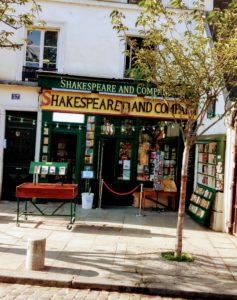
Within seconds of walking through the door I find myself flipping through a little book called Love by Jeanette WInterson that I haven’t seen before. I’m deep into her commentary on gender identity in Written on the Body when I force myself to put it down. It’s too easy for me to get swept away into all of the new titles in English (on this trip I’m reading on a Kindle, sadly, and I can’t justify buying real books, double sadly). So I head upstairs to the free reading library. It’s a lovely space to explore, surprisingly not as dusty as I’d think, with its random rows of books and velvet-covered benches offering plenty of cozy reading (or napping) nooks. I see a sign on the wall that reads, “Aggie the cat was up all night. Please let her sleep.” But Aggie the cat doesn’t seem interested in sleep. She’s found the comfortable lap of a woman in a white sweater and oversized round glasses who is giving away endless pets.
Sylvia Beach may not have owned this incarnation of Shakespeare and Company, but her spirit remains. Upstairs I find a tribute to her on the wall referencing a quote by French writer Andre Chanson: “Sylvia carried pollen like a bee. She cross-fertilized these writers…She did more to link England, the United States, Ireland, and France than four great ambassadors combined.” Unity through literature and a woman orchestrating it all. What a concept.
It’s fast approaching 11:00, so I decide to head back to Monnaie de Paris. The exhibition I want to see, Women House, is a modern-day homage the the 1972 Los Angeles exhibition, Womanhouse. In an exhibition spanning multiple rooms, art in several mediums is used to connect, examine, and confront female gender identity with domesticity. The exhibit is profound, sometimes funny, sometimes dark, and always insightful. (The exhibition is so fantastic I wrote an entire blog entry about it that you can read here.)
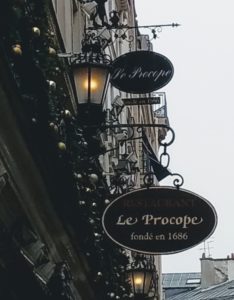
My breakfast croissant long forgotten, I decide to do something about le dejeuner. I’ve never been to Le Procope before, but as it’s believed to be the oldest café in continuous operation in Paris (and is, you guessed it, in my neighborhood) I figure today is the day I should go there. The restaurant opened in 1686 (yes, you’re reading that date right) as a place where fashionable gentlemen could drink coffee. We might even say that coffee culture exists today because of le Procope. During the 18th century it became a meeting place for artists and intellectuals, with regulars including Voltaire, Thomas Jefferson, and Benjamin Franklin. Voltaire came here so often — allegedly drinking up to 100 espressos a day, flavored with chocolate — that his desk is still upstairs for diners to see. The café also was a meeting place during the Revolution and maintained its intellectual appeal long after.
I’m not here today to start a revolution, though. I’m here to eat lunch. The inside of the restaurant is spacious, warm, and classy, having been refurbished in the late 1980s in 18th century style. The walls are a deep red, crystal chandeliers hang above, and all around are framed photos of past patrons. When I arrive, it’s still early in the afternoon, and a friendly hostess quickly seats at one of the cozy tables in a back room. I stick to traditional French fare: my favorite tartare du boeuf avec des frites et un petit carafe du vin. While most of the diners seem to be international tourists, the food is still tasty and worth the expense.
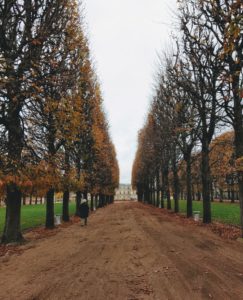
After lunch, I decide to digest all of that good food and wine with a stroll at le Jardin du Luxembourg. It’s been a favorite spot of mine these past few months, as a place to run and a place to roam, and I never tire of exploring its dirt paths and hidden foliage. As the days get shorter and colder, there are fewer leaves on the trees and fewer people out and about, but there are always people here, walking, reading, chatting, contemplating. I do a lap around the perimeter, stopping to say hello to my favorite tree and listen to my favorite street musician playing his violin.

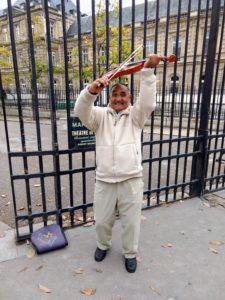
At the exit at Le Musée du Luxembourg, I head out to the road. My final stop for the day is another recent discovery for me. I just finished reading Djuna Barnes’s Nightwood, and was excited when I realized that many of the characters in the novel live in my neighborhood. This poetic and challenging novel, published in 1936 and praised by T.S. Eliot as “so good a novel that only sensibilities trained on poetry can wholly appreciate it,” was groundbreaking for its portrayal of lesbian love. It also pushed (heck, it still pushes today) the boundaries of gender. One of the characters, Dr. Matthew O’Connor (not a real doctor) is found in his apartment late at night by Nora, a woman desperate for consultation after her lover, Robin, leaves her for another woman. Dr. O’Connor is wearing women’s clothing, makeup, and a blonde wig, clearly waiting for someone else. While, of course, the novel doesn’t use the term trans woman, clearly it, similar to Virginia Woolf’s Orlando, raises the issue of gender in a non-binary way.
In the novel Dr. O’Connor lives on a nondescript street just across from le Jardin du Luxembourg, Rue Servandoni, and dines and drinks regularly at Café de la Mairie, a tiny café that looks over Place Saint-Sulpice. The café is still there. And so today I walk along Rue Servandoni, wondering which apartment building Barnes imagined for Dr. O’Connor, and stop for an aperitif at Café de la Mairie.
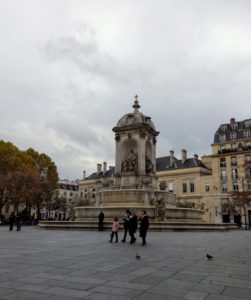
It’s the perfect ending to the day’s wanderings, sipping rosé outside at Café de la Mairie while I watch the sun battle with the sky, trying to make a late-afternoon appearance in the day. Early in Nightwood, Dr. O’Connor is drinking at the café on evening and is summonsed to the hotel room of a woman who has fainted and won’t wake up. It’s at the hotel, “one of those middle-class hostelries which can be found in almost any corner of Paris, neither good nor bad, but so typical that it might have been moved every night and not have been out of place,” that the reader first meets Robin Vote, a complex character taken to wandering the world for hours, days, weeks. She gets a lot of slack for being a heartbreaker (see above: Nora) but as a wanderer myself, I have to admit that I relate to her struggle, and commend her for being a woman who ping pongs between her need for love and security and her need for freedom and discovery.
I raise my glass to another literary flâneuse.
Epilogue: I finish writing this from my new apartment in le Marais. It’s only a mile from my old neighborhood, yet it feels like I’ve landed in a new city entirely. And like Robin Vote, I feel torn. On one hand, I’m excited to explore this new place, to discover what’s inside its hidden shadows. On the other hand, I already miss my familiar. Just yesterday, I had to walk back to my old neighborhood as I had forgotten something at my apartment. I had drinks with my old landlords and a nice chat, and on the walk back to my new neighborhood, I noticed a patisserie I hadn’t seen before.
I was stunned as I stared through the window at the beautiful display of tartes and macarons. How could I have missed this? As I kept walking on a street I’ve walked on dozens of times before, I spotted galleries I’d never noticed, statues tucked in corners. I remembered that one interesting-looking café whose name I never knew, at the intersection with that one street that I’d passed so many times and thought, “I need to eat there some day.”
But I need to learn that it shouldn’t be a source of distress. There is always something more we can unearth from a place, another layer we can uncover. Even if you live in a place your entire life, there’s something else you can find, a new café, a new gallery, a fallen leaf from a tree. Those of us who need to roam keep going because that drive to discover something beyond pushes us further. But at the same time we know we can always return to the familiar, to the places known yet still unknown, when we need it the most.
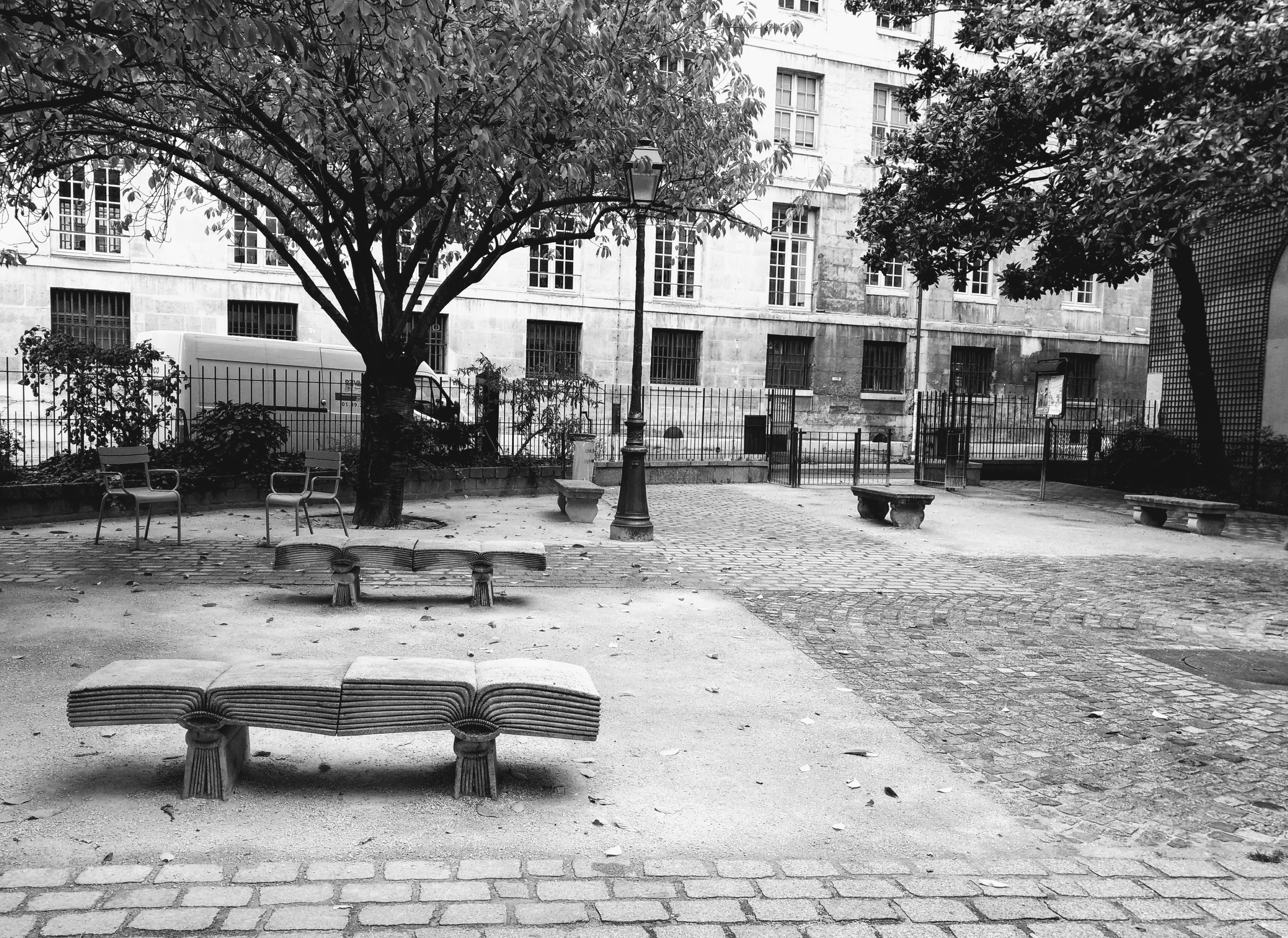



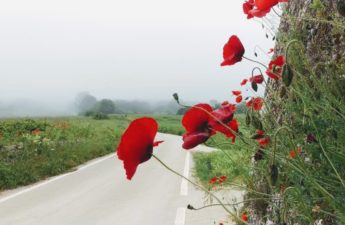
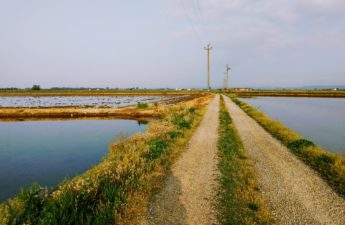
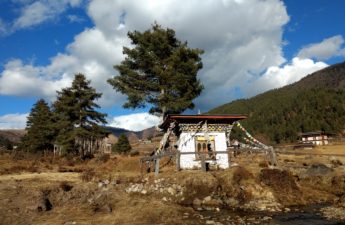
Those book benches call for sitting on, or laying and reading.
I’m glad I finally got to share those benches — an unexpected highlight for me!
Of course I loved reading about your old neighborhood, but I got both hungry and envious reading about the new cafe you ate le dejeuner at—my mouth salivates for le boeuf tartare!!!!!
It was delicious! I wish I knew about the Women House exhibition when you were visiting (I think it opened right around the time you left). You would have loved it.
(I edited your post to fix the missing I’s — would love to see you respond after a martini!)
I wish to go to Shakespeare and Company. It sounds awesome! Another great blog, thanks!
You’ve never been there???? We’ll go in January when you and N come visit me (in between les verres de vin!)
So much food for thought here (and food, period, of course)! I can imagine feeling quite jealously protective of the old neighborhood and therefore petulantly resistant to enjoying the new, for a little while at least (before I come to my senses). But that’s me being neurotic and crazy. Still, how nice that you forgot something and had to go back!
(And how nice that you have a whole new neighborhood to explore! Go to La Belle Hortense for books and wine, and to Au Fer du Cheval across the street for dinner at the not-so-secret restaurant in the back!)
Oh, I know right where those are — have been to other cafés literally a few doors down. When I was here in Paris in 2013 I lived near Place de la Bastille, in the 11th, so I walked through Marais almost daily on my way to/from.
I know I’ll wander back to my old neighborhood from time to time (just as I’ve wandered over to this neighborhood on occasion) but I do need to take advantage of getting to know this area for a few weeks as that was the whole point of moving here!